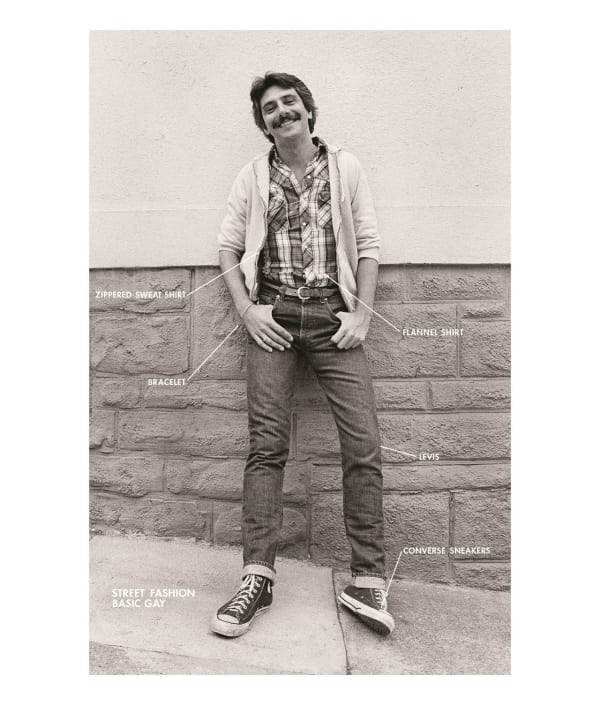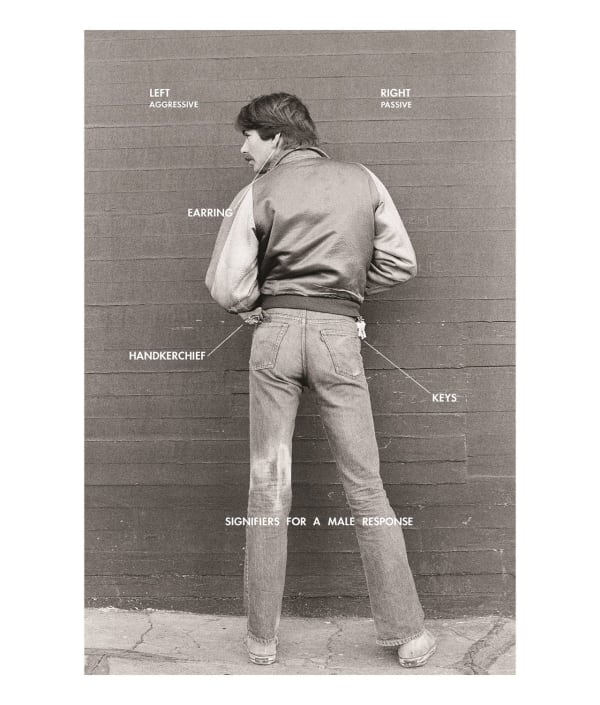Hal Fischer’s photography series, Gay Semiotics, deconstructed the ways his queer contemporaries in 1970s San Francisco presented themselves. Here, Fischer tells Another Man the story behind the series – and why he would never do a modern-day version
Between 1977 and 1979, American artist Hal Fischer created Gay Semiotics, a landmark series of photo-text works providing a pioneering analysis of gay historical vernacular as it unfolded on the streets of San Francisco’s Castro and Haight-Asbury districts. Inspired by the work of August Sander, Fischer made a series of street black and white portraits of gay archetypes accompanied by text that deftly deconstructed the symbols of the era’s quintessential looks such as Natural, Classical, Jock, Hippie, Urbane, Forties Trash, Western, Leather, Dominance, and Submission – along with detailed descriptions of signifiers like keys, earrings, handkerchiefs, leather apparel, gag mask, amyl nitrate, and other bondage devices. In advance of the publication of The Gay Seventies, Fischer looks back on one of the first conceptual works to bring the structuralism and linguistics to photography and reflects on the nature of gay semiotics today.
“I came to San Francisco for graduate school, but I arrived in an extraordinary time. It was called ‘the center of the gay universe’ in my book and I was part and parcel of the freedom of all of that. The beauty of the 1970s, particularly in California, was that nobody had money, nobody was making money, and nothing was selling so you did what you wanted.
“There was a big photography and language exhibition organized by Lew Thomas that predates my gay work. I met Lew because I was writing art reviews and did one of his show. I struggled because I didn’t understand the work completely, but I gave it a go. Lew became my mentor and he gave me books to read, like The Structure of Art by Jack Burnham. I had been writing and drawing on photographs since college, and I had this aha moment: This is what is happening around me!
“That was the genesis of the first pictures, The Signifiers of Male Response. The 24 pieces for Gay Semiotics came together in just six months. I started it and built on it, then Donna-Lee Phillips and I were organizing an erotic photography show for Camerawork that ultimately became the book Eros in Photography. They asked if I would write an essay for the book and that became the essay for Gay Semiotics.
“I was very aware of contemporary trend, but I wasn’t setting out to be a documentary photographer. It was about my desire as a young white gay man living his life in San Francisco. I was an artist making art, but I was using what was around me: ‘the great gay migration’ that came to San Francisco. What I captured is what existed here: the freedom to be who you are.
“There is an art history play going on in the work. Even in the S&M images, the posing is based on some 19th-century sculpture. My street fashion pictures are deeply influenced by August Sanders. One of the things I loved about Sanders is that he worked in Germany at a time when people were defined by class and profession; when they assumed a pose, they instinctively took the pose that reflected that. I waited to see how [my subjects] would stand. I didn’t dress those people; I found them like that.
“I’ve had people come up to me and tell me that they found the book in their library and it was their first contact with anything gay. I’ve been shocked that people still love it. I think Gay Semiotics is seen as something of a ‘Golden Age of Gay’. I’m glad I had my time because it was fun.
“People ask if I’d like to do Gay Semiotics again and I say no. I would never try to discern the semiotics of people in their twenties. I can’t tell who’s gay anymore. I don’t think this generation (of gay populations in urban centers) has a semiotics. On one level, they don’t need it. On the other level, everything is very porous. The transmission of style happens so quickly now that even if you could say, ‘This is gay,’ in a week it will be something else because it was absorbed.
“For every group, at a certain point, there is a nostalgia for what it was when you weren’t assimilated and had your own identity. There was a separation and I don’t think that’s there at this point. It’s a funny contradiction. Something gets lost and you have to come to terms with that – but at the same time, we got all these other things.”
Hal Fischer: The Gay Seventies will be released on October 22, 2019, published by Gallery 16 Editions. Thought Pieces: 1970s Photographs by Lew Thomas, Donna-Lee Phillips and Hal Fischer will be on view at SFMOMA from January 4 – August 9, 2020.


